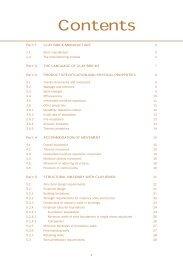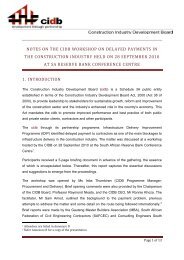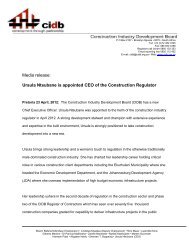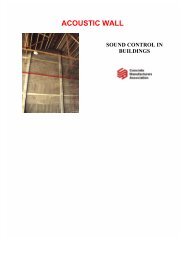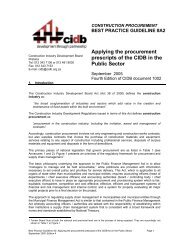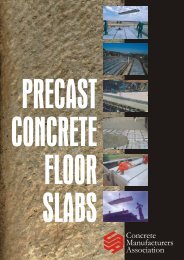MANUAL 4 - Construction Industry Development Board
MANUAL 4 - Construction Industry Development Board
MANUAL 4 - Construction Industry Development Board
You also want an ePaper? Increase the reach of your titles
YUMPU automatically turns print PDFs into web optimized ePapers that Google loves.
<strong>MANUAL</strong> 4 – BITUMINOUS PAVEMENT SEALS<br />
Minimum temperature<br />
°C<br />
0<br />
15<br />
20<br />
25<br />
6.5 Design of slurry<br />
6.5.1 Slurry seal binder content<br />
Spraying temperature<br />
°C<br />
50<br />
50<br />
50<br />
50<br />
Table 4.7: Heating times for binder<br />
Approximate time to heat<br />
210 litre drum (min)<br />
30 – 40<br />
20 – 30<br />
20 – 25<br />
15 – 20<br />
The slurry seal binder must be a stable grade 60% Anionic emulsion. The bulking of the<br />
aggregate must be taken into consideration when determining the amount of emulsion<br />
required for the mix.<br />
Table 4.8 gives an indication of the slurry seal binder content for a range of traffic volumes<br />
per m 3 of dry aggregate.<br />
Traffic volume (vpd) Binder content (litres/m 3 )<br />
50 – 500<br />
500 – 1 500<br />
1 500 – 2 500<br />
6.5.2 Water content of slurry<br />
Table 4.8: Binder content<br />
60<br />
240<br />
230<br />
The approximate amount of water to be added to the slurry is 235 litres per m 3 .<br />
This amount could either be increased if the aggregate is completely dry and hot conditions<br />
prevail, or reduced if the aggregate is damp.<br />
It is recommended that a trial mix be prepared and, once the amount of water required is<br />
established, it is used consistently for the rest of the work to obtain a uniform mix.<br />
6.5.3 Aggregate for the slurry<br />
Grading of aggregate<br />
The aggregate for the Cape seal slurry must be carefully selected. Generally speaking,<br />
the medium grade grading for the slurry must be selected. The grading curve depicted in<br />
Table 4.9 can be used as a guide for selecting the aggregate.<br />
Sieve size (mm) Percentage by mass passing<br />
6,700<br />
4,750<br />
2,360<br />
1,180<br />
0,600<br />
0,300<br />
0,150<br />
0,075<br />
Table 4.9: Grading of aggregate<br />
100<br />
82 – 100<br />
56 – 95<br />
37 – 75<br />
22 – 50<br />
15 – 37<br />
7 – 20<br />
4 – 12<br />
IMPLEMENTING EMPLOYMENT INTENSIVE ROAD WORKS 71<br />
MODULE<br />
1<br />
2<br />
3<br />
4<br />
5<br />
6<br />
7





